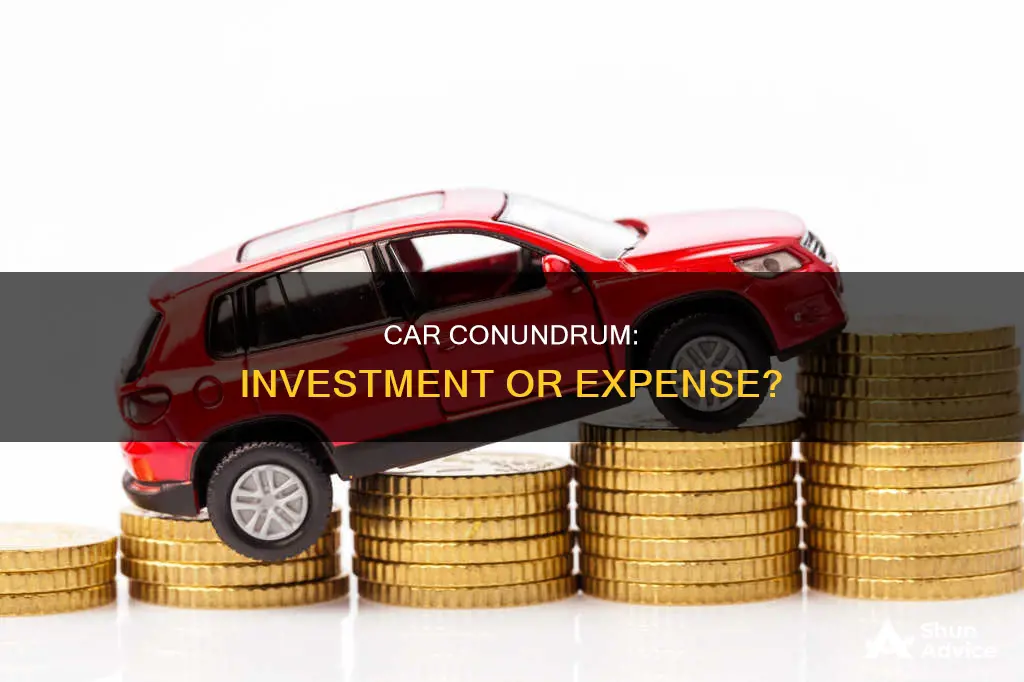
Buying a car is a significant financial decision, and it is essential to understand whether it is considered an investment or consumption. In economic terms, investment refers to spending on capital equipment, inventory, and structures by firms, while consumption is any spending on final goods and services by households. When an individual buys a car, it is generally classified as consumption, as it represents a substantial financial outlay on an asset that depreciates over time. On the other hand, if a company purchases a car, it is considered an investment because it provides long-term benefits and contributes to the increase in GDP.

Depreciation
On average, cars lose 10-15% of their value per year, with higher depreciation rates in the first few years of a vehicle's lifespan. Some sources state that cars can lose up to 20% of their value in the first year alone. This is due to a combination of wear and tear, market demand, subsequent redesigns, and economic forecasts. Luxury vehicles and electric cars tend to have the highest depreciation rates, while trucks and hybrids tend to retain their value better.
There are several factors that influence how much a car depreciates:
- Make and model: A popular make and model will likely retain its value longer than one with fewer fans.
- Age: Older vehicles generally lose value, with certain exceptions, such as classic cars.
- Condition: A vehicle with normal wear and tear will retain its value better than one that has been in accidents or used for work.
- Mileage: Vehicles have an upper limit on the number of miles they can accumulate without requiring major, expensive repairs.
- Ownership history: A vehicle with multiple previous owners will likely depreciate faster.
- Colour: A custom paint job will likely depreciate a car more than a standard colour.
While depreciation is inevitable, there are steps that can be taken to limit how much value a vehicle loses:
- Limit mileage: Putting less than 10,000 miles per year on a vehicle keeps the odometer reading low and reduces the risk of accidents and damage.
- Covered parking: Reducing exposure to the elements preserves the vehicle's exterior and limits damage from severe weather.
- Regular maintenance: Following the manufacturer's recommendations for maintenance, such as oil changes and tire rotations, can help extend a vehicle's lifespan and preserve its resale value.
Tesla: Invest or Avoid?
You may want to see also

Running costs
Running a car is expensive. In fact, the average monthly cost of owning a car has surpassed $1,000. The average monthly payment on a new car was $735 in the first quarter of 2024, according to Experian.
There are many costs to consider when running a car. Fuel is one of the most variable costs, with prices changing almost daily. The average driver paid around 15.93 cents per mile for regular unleaded gas in early 2023. Over a 15,000-mile year, that's $2,390 annually. Maintenance and repairs are another significant expense, with the average cost for a new car being $123 per month. This includes common maintenance costs such as oil changes and tire rotations, which are usually done at 5,000-mile intervals.
Registration, fees, and taxes are also necessary expenses. The average car owner will pay $762 in 2023 for licensing, registration, and taxes to legally drive their vehicle. The cost of these fees varies by state. Additionally, almost every state requires some form of auto insurance coverage. The average annual premium for full-coverage insurance is $1,765.
Another cost to consider is depreciation. Cars typically lose around 15% to 20% of their value in the first year and around 15% per year over the next four years. This means that a car is a depreciating asset, losing value over time.
Other costs to consider include parking, breakdowns, and road tax. When calculating the total cost of owning a car, it is essential to consider all these factors to understand the true expense of car ownership.
Investing for Retirement: A Conservative Approach to Financial Security
You may want to see also

Leasing vs buying
Leasing a car is like renting it for an extended period. You pay for the amount of depreciation that is expected to occur during the term of the lease, plus interest and fees. On the other hand, buying a car means that you own the vehicle once your payments have been made.
Leasing a Car
Leasing a car usually involves a monthly payment to drive a new car for a set term, which is often lower than the monthly cost of financing a vehicle purchase. This allows you to drive a vehicle that may be more expensive than you could afford to buy. However, you must return the car at the end of the lease term and leasing usually costs more than an equivalent loan as you pay for the car during its most rapid depreciation period.
Leasing also comes with a few disadvantages. Firstly, monthly payments go on forever if you lease one car after another. Secondly, lease contracts specify a limited number of miles and you will have to pay an excess mileage penalty if you go over the limit. Thirdly, you will be charged for excess wear and tear if you do not maintain the vehicle in good condition. Fourthly, there may be significant costs if you end the lease early. Finally, you may have to pay a fee when you return the vehicle at the end of the lease.
Buying a Car
Buying a car is more expensive in the short term as you have to pay the entire purchase price of the vehicle upfront. However, once you pay off your loan, your payments end. Any equity you have in the car can then be used toward the purchase of a new car.
There are several advantages to buying a car. Firstly, you can drive as much as you want without worrying about mileage limits. Secondly, you can get cash to pay for your next car when you sell or trade in your current vehicle. Thirdly, you can make the car your own by customising it however you like. Fourthly, you won't have to make payments once the loan is paid off. Fifthly, you can sell the car on your own schedule. Sixthly, financing is generally easier than leasing. Finally, you can fix the car yourself or choose not to fix it at all.
However, there are also some disadvantages to buying a car. Firstly, it is more expensive in the short term as you have to pay the entire cost of the vehicle upfront. Secondly, you have to pay interest on the entire cost of the car, minus your down payment and trade-in. Thirdly, you may have to pay more sales tax. Fourthly, it is recommended that you make a large down payment to get the best loan rate and shortest term. Finally, the car's future value is unknown, and its warranty will eventually end.
So, Which is Better?
There is no easy answer to the question of whether it is better to buy or lease a car. Each method has its pros and cons and the best option for you will depend on your current financial picture, automotive needs, and future plans.
Investing in Yourself: Why the Fear?
You may want to see also

New vs second-hand
When it comes to buying a car, there are several factors to consider. Firstly, one must acknowledge that a car is a depreciating asset, meaning it will lose value over time. Thus, from a purely financial perspective, buying a car may not be considered a good investment. However, if you need a car for your daily commute or frequent long-distance travel, it can be a worthwhile purchase.
There are several advantages to buying a new car. Firstly, you get to be the first owner, and you have the option to customise the car to your exact specifications, choosing the colour, equipment, and accessories. A new car will also come with a full manufacturer's warranty, which can provide peace of mind in case of any issues. Additionally, new cars feature the latest technology, offering improved fuel efficiency and enhanced safety features.
On the other hand, new cars are significantly more expensive than used cars, and they also depreciate faster, losing up to 20% of their value in the first year. You may also have to wait longer for a new car due to manufacturing delays, and insurance premiums tend to be higher because of the higher value and cost of replacement parts.
Opting for a second-hand car can offer significant cost savings, as you can often get a higher-specification model for the same price as a basic new car. Used cars are readily available, so you don't have to wait for delivery, and insurance rates tend to be lower.
However, when buying a used car, you may not have a warranty or may have a reduced warranty period. Additionally, older cars are generally more prone to issues and may require more frequent servicing and maintenance. MOT tests are also required annually for cars over three years old, adding to the maintenance costs.
When considering whether to buy a new or second-hand car, it's important to weigh your priorities and budget. If having the latest model, customisation options, and a full warranty are important to you, then a new car may be the better choice. However, if cost savings and immediate availability are more crucial factors, a used car could be a more suitable option.
Franklin Templeton-Putnam Deal: A Merger of Investment Giants
You may want to see also

Financing
Payment Options
When financing a car, you have two payment options: pay for the vehicle in full or finance the car over time with a loan or a lease. Most car purchases involve financing, but it's important to be aware that financing increases the total cost of the vehicle. This is because you're paying for the cost of credit (interest and other loan costs) on top of the vehicle's price.
Loan Factors
There are three major factors to consider when using a loan to finance a car: the loan amount, the annual percentage rate (APR), and the loan term. The loan amount is the total sum of money you borrow to buy the car. The APR is the interest rate you pay on the loan, and this is determined by your credit score, which assesses your creditworthiness. The loan term is the amount of time you have to pay back the loan.
Down Payment
You usually make a down payment, which is a percentage of the car's price, and then borrow or finance the rest. Making a down payment of at least 20% of the loan amount generally results in better loan terms. A larger down payment means borrowing less and, therefore, paying less interest over the life of the loan.
Advantages of Financing a Car
Disadvantages of Financing a Car
One of the biggest downsides of financing a car is the cost. Over the loan term, you will end up paying more than the car is worth due to interest rates and other fees. Financing may also limit your vehicle options, as some lenders only provide loans for specific types of purchases. For example, a bank might not offer a loan for a car that is more than 10 years old. Another disadvantage is the insurance requirement. Lenders often mandate borrowers to have a full-coverage car insurance policy throughout the loan term, which can be more expensive than minimum coverage policies.
The Mortgage-Investing Conundrum: Seeking Financial Freedom
You may want to see also
Frequently asked questions
Buying a car is generally considered consumption, not investment. This is because a car is a depreciating asset, meaning it loses value over time.
In an economic sense, investment is spending on capital equipment, inventory, structures, and new homes. Consumption is any spending on final goods and services by households, except for new homes.
A car is considered consumption because it is an object that will cost money year after year. These costs include insurance, taxes, servicing, fuel, parking, and breakdowns.
Yes, there are benefits to buying a car. For example, if you need to travel long distances or to rural areas, having a car can be advantageous. Additionally, if you are travelling with multiple people, such as a family, a car may be more cost-effective than alternative modes of transportation.







